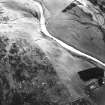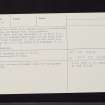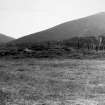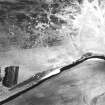Pricing Change
New pricing for orders of material from this site will come into place shortly. Charges for supply of digital images, digitisation on demand, prints and licensing will be altered.
Drumelzier
Cairn (Prehistoric), Cairn (Bronze Age), Ring Marked Stone (Neolithic) - (Bronze Age), Beaker
Site Name Drumelzier
Classification Cairn (Prehistoric), Cairn (Bronze Age), Ring Marked Stone (Neolithic) - (Bronze Age), Beaker
Canmore ID 49902
Site Number NT13SW 12
NGR NT 12360 32620
Datum OSGB36 - NGR
Permalink http://canmore.org.uk/site/49902
- Council Scottish Borders, The
- Parish Drumelzier
- Former Region Borders
- Former District Tweeddale
- Former County Peebles-shire
NT13SW 12 1236 3262.
(NT 1236 3262) Cairn (NR)
OS 6" map, (1967).
This cairn is situated on a low gravel knoll on the right bank of the River Tweed. It was excavated in 1929 and 1930.
The process of erosion has carried away part of the knoll on which the cairn stands, together with a segment of the SW arc of the cairn itself. The cairn material was found to be spread over an area measuring about 40' in diameter with a maximum height of 2', but a ring of boulders which had apparently marked the original perimeter indicated that initially the cairn had a diameter of about 30'. In all, seven cists were located (1 - 7 on RCAHMS 1967 plan, fig.5), together with a cist-like hollow (8) and three settings of stones (9 - 11) which may originally have been cists.
Cists 1 - 3 were all typical Bronze Age short cists, except that 1 and 2 were formed of boulders and not slabs. No capstone was found in situ on either cist 2 or cist 3, but it was suggested that they may originally have been covered by the slabs Z and Y respectively. A complete Cord-Zoned Beaker stood upright near the centre of cist 1, and a fragment of another Beaker, a sherd of Secondary Neolithic pottery of Peterborough type, a flint saw and thirteen flakes of flint and chert were also recovered from it. No relics were discovered in cists 2 and 3, but near slab Z were found sherds belonging to about half of one Cordoned Urn, part of the rim of another and parts of the bodies of three others. In addition, part of a jet armlet was found near the slab. No indication is given in the excavation report of the precise positions and levels at which these relics were found.
Cists 4 - 7 were all smaller than those already described; although apparently undisturbed, they produced only one fragment of charcoal and part of a charred hazel nut.
Between cists 1 and 2 a penannular setting of stones (9), measuring 1'11" in diameter, was discovered on the original ground surface. In the centre of this setting a small fragment of iron was found resting on a flat paving stone. Two other settings of stones were revealed a short distance to the NE. The first of these (10) contained a fragment of a Cinerary Urn, and the second (11) is described as having at first "suggested a flue", but also as having been "partially destroyed", so that its original purpose is not evident.
In addition to the cists and stone settings there was also found, at a point 8' to the S of cist 1, an "oblong cist-like excavation without slabs, cut to a depth of 3' below the top of the cairn". This pit (8) measured, as excavated, 4'6" in length by 2'4" in breadth and about 1' in depth. No artifacts were found in it, but at a point a little SW of the centre the excavator recorded a dark circular area 1'8" in diameter which contained "charcoal", and which extended into the subsoil to a depth of 3" below that of the rest of the floor of the pit.
The slab Z found in the NNE part of the cairn may have originally covered cist 2, as the excavator suggested. It measures 3' by 2'6" and is notable in having on its surface incised markings of an unusual character. They consist of a group of four shallow double-ringed figures and one single ring, the former measuring from 3" to 4" in diameter and the later 1 3/4". The markings are incised by pecking, and the grooves so formed are only 1/4" in width and very shallow.
It seem possible that the history of the cairn was broadly as follows. The original cairn measured about 30' in diameter, its periphery being marked by a kerb-like ring of boulders. The earliest burials seem to have been those in cist 1 and pit 8, both of which are well within the body of the cairn. Subsequently on one or more occasions six more cists (2 - 7) and the three stone settings (9 - 11) were inserted, all, except cist 4, in the NE quadrant, an all of them breaking through the line of the original periphery. The fact that all these secondary structures lie either among, or just outside, the boulders forming the periphery suggest that if, as seems probable, they were constructed actually in cairn material, then the initial cairn must have spread considerably beyond its original limits before they were made. Cist 3 and probably cist 2 were added during the Bronze Age; the dates of the remainder are not at all certain. But the discovery of a fragment of iron, the jet armlet and part of a whetstone, suggests disturbance during the Early Iron Age. The discovery of Early Iron Age relics in a cairn of an earlier period is parallelled, for example, at Stockie Muir, Stirlingshire.
The finds from the excavation are in the National Museum of Antiquities of Scotland (NMAS), and part of a calcined flint knife and two waste chips of chert found "recently" (c 1962) at this cairn were donated to the NMAS in 1962-3 by W F Cormack, FSA Scot.
RCAHMS 1967, visited 1964; J H Craw 1931; Proc Soc Antiq Scot 1965 (Donations).
As described by the RCAHMS.
Re-surveyed at 1:2500.
Visited by OS (RDL) 16 March 1964 and (IA) 14 August 1972.
This cairn has been disturbed, stone 'Z' having been overturned.
A G Mein 1979.
Sbc Note
Visibility: This site has been excavated.
Information from Scottish Borders Council












































